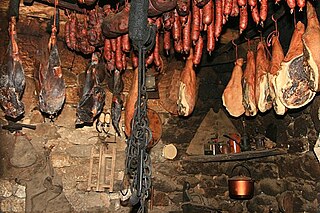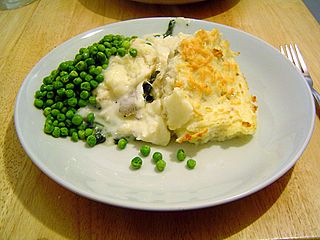
Chowder is a thick soup prepared with milk or cream, a roux, and seafood or vegetables. Oyster crackers or saltines may accompany chowders as a side item, and cracker pieces may be dropped atop the dish. Clam chowder from New England is typically made with chopped clams and diced potatoes, in a mixed cream and milk base, often with a small amount of butter. Other common chowders include seafood chowder, which often consists of fish, clams, and other types of shellfish; lamb or veal chowder made with barley; corn chowder, which uses corn instead of clams; various fish chowders; and potato chowder, which is often made with cheese. Fish, corn, and clam chowders are popular in North America, especially Atlantic Canada and New England.

An omelette is a dish made from eggs, fried with butter or oil in a frying pan. It is a common practice for an omelette to include fillings such as chives, vegetables, mushrooms, meat, cheese, onions or some combination of the above. Whole eggs or egg whites are often beaten with a small amount of milk, cream, or water.

Finnish cuisine is notable for generally combining traditional country fare and haute cuisine with contemporary continental-style cooking. Fish and meat play a prominent role in traditional Finnish dishes in some parts of the country, while the dishes elsewhere have traditionally included various vegetables and mushrooms. Evacuees from Karelia contributed to foods in other parts of Finland in the aftermath of the Continuation War.

The haddock is a saltwater ray-finned fish from the family Gadidae, the true cods. It is the only species in the monotypic genus Melanogrammus. It is found in the North Atlantic Ocean and associated seas, where it is an important species for fisheries, especially in northern Europe, where it is marketed fresh, frozen and smoked; smoked varieties include the Finnan haddie and the Arbroath smokie. Other smoked versions include long boneless, the fileted side of larger haddock smoked in oak chips with the skin left on the fillet.

Kedgeree is a dish consisting of cooked, flaked fish, boiled rice, parsley, hard-boiled eggs, curry powder, lemon juice, salt, butter or cream, and occasionally sultanas.

Danish cuisine originated from the peasant population's own local produce and was enhanced by cooking techniques developed in the late 19th century and the wider availability of goods during and after the Industrial Revolution. Open sandwiches, known as smørrebrød, which in their basic form are the usual fare for lunch, can be considered a national speciality when prepared and garnished with a variety of ingredients. Hot meals are typically prepared with meat or fish. Substantial meat and fish dishes includes flæskesteg and kogt torsk with mustard sauce and trimmings. Ground meats became widespread during the industrial revolution and traditional dishes that are still popular include frikadeller, karbonader and medisterpølse. Denmark is known for its Carlsberg and Tuborg beers and for its akvavit and bitters, but amongst the Danes themselves imported wine has gained steadily in popularity since the 1960s.

Smoked meat is the result of a method of preparing red meat, white meat, and seafood which originated in the Paleolithic Era. Smoking adds flavor, improves the appearance of meat through the Maillard reaction, and when combined with curing it preserves the meat. When meat is cured then cold-smoked, the smoke adds phenols and other chemicals that have an antimicrobial effect on the meat. Hot smoking has less impact on preservation and is primarily used for taste and to slow-cook the meat. Interest in barbecue and smoking is on the rise worldwide.

The Arbroath smokie is a type of smoked haddock, and is a speciality of the town of Arbroath in Angus, Scotland.

Cullen skink is a thick Scottish soup made of smoked haddock, potatoes, and onions. An authentic Cullen skink will use finnan haddie, but it may be prepared with any other undyed smoked haddock. Sometimes ocean perch or salmon are used in the soup.
Norwegian cuisine in its traditional form is based largely on the raw materials readily available in Norway. It differs in many respects from continental cuisine with a stronger focus on game and fish. Many of the traditional dishes are the result of using conserved materials because of the long winters.

Findon or Finnan is a fishing village eight miles south of Aberdeen, famous for originating the smoked haddock known as Finnan haddie. The Findon moor has a number of paths through it, many of which run along the cliffs. Deer can often be seen there. Nearby features include the Portlethen Moss Nature Reserve.

Smoked fish is fish that has been cured by smoking. Foods have been smoked by humans throughout history. Originally this was done as a preservative. In more recent times fish is readily preserved by refrigeration and freezing and the smoking of fish is generally done for the unique taste and flavour imparted by the smoking process.

Scottish cuisine encompasses the cooking styles, traditions and recipes associated with Scotland. It has distinctive attributes and recipes of its own, but also shares much with other British and wider European cuisine as a result of local, regional, and continental influences — both ancient and modern.

Fish pie, also known as fisherman's pie, is a traditional British dish.

A full breakfast or fry-up is a substantial cooked breakfast meal often served in Great Britain and Ireland. Depending on the region, it may also be referred to as a full English, a full Irish, full Scottish, full Welsh or Ulster fry. The fried breakfast became popular in Great Britain and Ireland during the Victorian era, with the full breakfast appearing in Isabella Beeton's Book of Household Management (1861).

Cured fish is fish which has been cured by subjecting it to fermentation, pickling, smoking, or some combination of these before it is eaten. These food preservation processes can include adding salt, nitrates, nitrite or sugar, can involve smoking and flavoring the fish, and may include cooking it. The earliest form of curing fish was dehydration. Other methods, such as smoking fish or salt-curing also go back for thousands of years. The term "cure" is derived from the Latin curare, meaning to take care of. It was first recorded in reference to fish in 1743.

Cod and other cod-like fish have been widely used as food through history. Other cod-like fish come from the same family (Gadidae) that cod belong to, such as haddock, pollock, and whiting.

Okoy or ukoy, are Filipino crispy deep-fried fritters made with glutinous rice batter, unshelled small shrimp, and various vegetables, including calabaza, sweet potato, cassava, mung bean sprouts, scallions and julienned carrots, onions, and green papaya. They are traditionally served with vinegar-based dipping sauces. They are eaten on their own or with white rice. They are popular for breakfast, snacks, or appetizers. Okoy are sometimes dyed bright orange with achuete seeds.

















